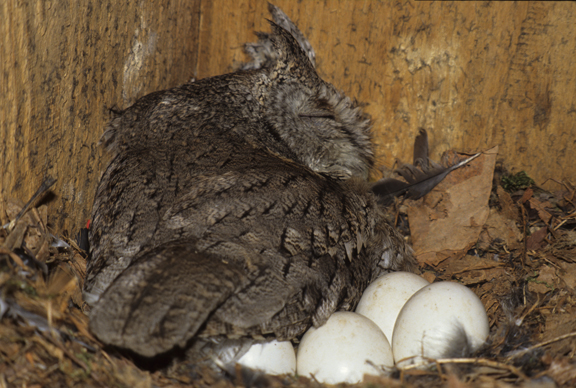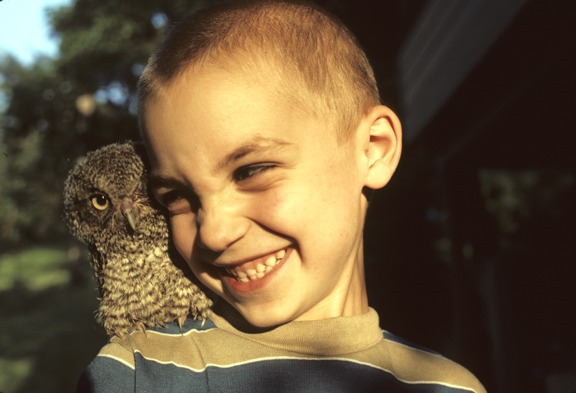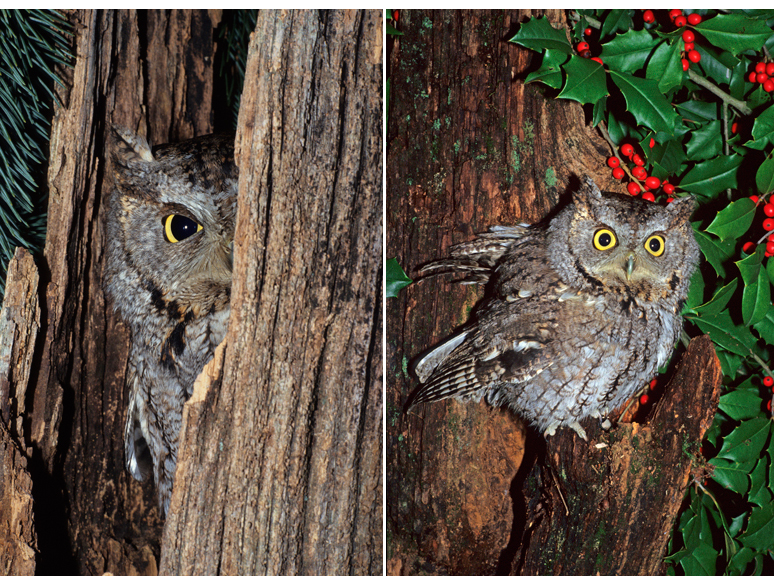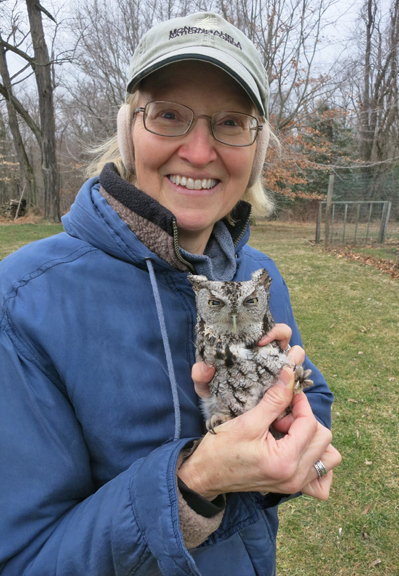In 1974 I received my Master Personal Bird Banding Permit. I chose to research the breeding biology of Eastern Screech-owls (EASO). For the next 28 years I was knee-deep in Screech-owls.
I began organizing Screech-owl counts associated with the Wheeling, WV, Christmas Bird Counts. Every year that we counted, we had the highest EASO number in North America.
Later I began a trapping program using bal-chatri traps. Through this I learned much about the secretive EASOs and also about myself: I developed an awareness of nature in a new and peaceful way. I became accustomed to being outside alone in what some would call horrible, unwelcoming weather. It showed me how absolutely wonderful it was to be comfortable in creation in all circumstances. Nothing compares to the quiet of cold, cold temperatures, treacherous roads and early morning hours. It’s a quiet that few ever experience. While everyone else was in bed, I was alone, outside, learning to be in touch with the very essence of life. I would gaze into the starlit sky and think about how I fit into the universe. Then a Screech-owl would arrive and I would think about trapping Screech-owls.

Thinking back on my EASO research, I believe the alone times trapping owls in the winter along remote gravel-dirt roads were my favorite times. I remember one night in particular. The night was cold, about 20 degrees, with 4 inches of snow on the ground. The snow was fresh and still covered the branches of the trees and bushes. Before going about my business of trapping an owl, my mind studied the patterns and images in the dark, snow-covered branches. If I looked for mountains, I saw them. Thinking of animals, I found distorted shapes of animals — perhaps a long snake with contrasting black and white stripes running the length of its body — maybe a small squirrel-shaped stub of broken branch with a massive tail composed of a thick tangle of snow-covered wild grape vines. There were partial faces, some friendly, but most contorted and fearful, as if ravenously protecting the forest from all unwelcome intruders. I valued these alone times immensely. If I had been with someone we would have talked about a multitude of things, not allowing my mind to pause and glory in the wonder of the universe. So often while alone in wild places I never noticed the cold, wind, rain and other elements that keep most people in the superficial comfort and apparent safety of their homes, but I was always sharply aware of the marvels of Nature that surrounded me.
Shortly after I began trapping EASOs I discovered something quite amazing about these little owls. The first few times I wanted to set a trap I would first make Screech-owl calls until I heard a response from a distant EASO. Then I would put the trap in a visible spot off the edge of the road and continue to call as I hid behind the car. Soon the owl came closer and onto the trap.
But soon I discovered that all my careful hiding and trying making the owl think no one was there was totally unnecessary. I found I could just stand in the open when I called the owl in. We could easily see each other. Most of the time the owl perched on a tree branch and watched me as I set the trap just below. Before I could even get back to the car I would hear a “THUMP” as the owl hit the trap.
Sometimes an EASO even hit the trap while it was still in my hands. The first time that happened, the shock seemed to stop my heart. The owls were much more interested in getting the food from the trap than they were worried about my presence.
In 1988 my approach to EASO studies changed significantly. The West Virginia Department of Natural Resources Wildlife Divisions Non-game Program awarded me a grant which allowed me to study EASOs in nesting boxes. With the money I bought climbing equipment to make it possible for me to “easily” get up to the nesting boxes. The state constructed 30 EASO nesting/roosting boxes per my specifications. West Liberty State College granted me permission to mount boxes in their 154 acre arboretum and in a wooded area on campus. I also placed boxes in the 14 acres behind my house. Two years later I left my job at the Brooks Nature Center in Oglebay Park. I had enjoyed working there but I wanted to be in the field more and still make a living at what I loved. Working at the Brooks Center, I had been limited to mostly night-time owl work. Now I was able to spend daytime with the owls. Although the surveys continued, most of the trapping ended.
Using the nest boxes, I was able to monitor the owls’ nests and behavior during breeding season and their roosting activities the rest of the year. Without injuring or disturbing the owls, I was able to watch and photograph many details of EASO life.


For many years I held a Federal Bird Rehabilitation Permit specifically for EASOs. It allowed me legally to keep and work with injured EASOs until the time they could be released back into the wild. Most adult injuries were car-related as the owls seem to be attracted to small mammals crossing roadways. The adult owls were ferocious and capable of significant scratches from their thin, but sturdy, sharp talons. To me, the worst injury was a talon under a fingernail or cuticle. This was painful and healed slowly. The baby owls also had attitude, but they didn’t have the strength or determination to back it up.
My children sometimes argued over who got to care for a young or injured owl. My son, Josh, was too young to care for an owl by himself, so he sometimes helped me. Julie and Kelly were old enough to be assigned the duties of feeding, exercising, and cleaning the cage of a particular owl, most often a young one.

One day I received a call from a lady in Washington, PA. She had been walking in the early morning and saw something unusual which she described as, “A pure white pile of feathers that moved.”
Upon closer examination she saw it was a baby bird unlike any she had ever seen. “It’s bigger, has tiny white feathers covering the body, and long claws on the toes,” she said. I suggested it might be a baby owl.
Once she knew I had permits to keep owls until they could be released, she was happy to bring the bird to me. It was a baby EASO. Unlike most other birds, newly-hatched EASOs have feathers covering their tiny bodies. Attempts to stand the little owl upright caused it to wobble back and forth, then lean to one side, and finally fall over. I guessed it was two days old. My family just adored this tiny baby. All other owls we had kept had been much older by at least by a week. (For baby birds, a week is a very long time. They change and grow up very quickly.) Everyone wanted to be part of this tiny one’s care, but I decided I would be its primary caregiver for the first week. Even so, when I fed or did anything with the baby, the entire family was present. Although the baby owl didn’t realize it, it had five doting parents.
I had always been adamant that we not name the owls we cared for because they would eventually be released. This little guy was different. Secretly, he came to be called, “Archie.” When I first heard the whispered references to “Archie,” I scowled (a little) but said nothing. Soon it was all out in the open and ARCHIE was a major topic of conversation. Unlike the other owls we had cared for, Archie had strongly imprinted on our family, and three young members of our family were strongly imprinted on Archie. After school, I could usually find my children lying on the floor surrounding the tiny feather ball, just watching and laughing, gently touching his soft feathers.
Archie liked having the top of his head lightly scratched, leaning in to get more. But he didn’t like our hands anywhere near his toes and feet. He would become wide-eyed, dance a bit, clack his beak, and backup, with a look that seemed to say, “I don’t like that. You should know better!” Foot sensitivity seems to be typical for owls — other owls we cared for had sometimes reacted hostilely when their feet were bothered, too.
Within 10 days of Archie’s arrival, he could easily have been mistaken for any other EASO his age if not for his uncharacteristic behavior. The door of his cage in the house was kept open and usually he would just sit on top of the cage. It was decided that Julie, my oldest child, would be Archie’s main caretaker, with Kelly’s help when necessary. Josh became the official Archie observer. Soon it was commonplace to see Archie on Julie’s shoulder being chauffeured around the house and yard. Archie spent more time in Julie’s bedroom than at his cage, and so did Kelly. I often saw all three kids playing outside with Archie perched nearby on a picnic table, on a low branch of a cherry tree, or even on a bicycle handlebar. Archie followed their every move as they played and ran around the yard. One day when we were all outside with Archie on the ground among us, a cat ran in and went right for Archie. All five of us lunged for the cat. It finally managed to escape with only a bruise or two and some well-deserved reprimands.
We decided that Archie needed a safer place to stay while outside. I attached a roomy wood duck box to a porch support that faced out into the yard. The box was low enough to allow us to reach it, but high enough to keep daytime marauding cats and dogs at bay. The box had a flat roof so Archie could either sit in the entry hole or stand on the roof top. Most of the time, he sat in the opening contentedly watching the other birds, visitors, and family activities.

Archie was fed commercially formulated food known as “predatory bird diet” for about 3 weeks. Then I announced it was time to introduce him to live mice for food to help him be ready to feed himself when he learned to fly. In a period of 24 hours, we discovered two shocking things about Archie. When I placed him on the floor and put a live mouse in front of him, instead of intently watching the mouse, clawing at it, or pouncing on it like other owls did, Archie became wide-eyed, turned, and ran to the nearest corner of the room. There he remained, cowering. Archie was afraid of mice! After supper that same day, we took Archie into the backyard for a flying lesson, as was our standard procedure. The usual method was to toss an owl gently into the air. Our rehab owls would spread their wings and gracelessly glide a short distance to land awkwardly in the soft grass. After repeating this process several times a day for three or four days, the owls made great progress in learning to fly. When Archie, on the other hand, was gently tossed into the air, he opened his wings, and, in a panic, flew straight into the ground. After several more attempts resulted in nose-dives straight into the ground I thought, “Archie is afraid of heights. Now what?” Now we knew we had an owl who was afraid of mice and afraid of heights.

His vulnerability made this young owl all the more endearing. Another discovery that really surprised me was the range of foods he would eat. One evening during supper, Archie was perched on a nearby cage while we were busily eating and talking about the events of the day. One of the kids accidentally dropped a piece of a beet on the floor. Archie jumped from the cage, ran over, picked up the beet, and swallowed it.
“Archie likes beets!” Kelly said excitedly.
All of a sudden another small piece of beet was on the floor and Archie ate it, too. “That’s enough,” I reprimanded. “He may eat beets, but that doesn’t mean they are good for him.”
“Well, if beets aren’t good for us, why do we have to eat them?” Josh asked, thinking he had found a chink in the family rule that everyone ate anything we grew in the garden.
“Archie is not an us,” I answered, but someone quickly rebuked me: “Archie IS one of us!”
The beet incident sparked a discussion which brought up a point that everyone needed to remember: Archie, like every other owl we had helped, would one day be released back into the wild. That sobering truth calmed everyone and we resumed eating. Later we discovered that Archie would also eat green beans and watermelon.
Unfortunately Archie was not making good progress toward becoming releasable. We were quickly approaching the 90 day point at which time, according to my rehabilitation permit, “Any owl not rehabilitated within 90 days is to be destroyed.”
Did Archie fit into this category? Well, Archie had never been injured, so he wasn’t being rehabilitated from some kind of injury that prevented him from surviving in the wild. So did that sentence apply to him? I had never believed in keeping owls as pets, so I knew he would eventually need to be released when he had learned the skills to survive. I didn’t want my children to view Archie as a pet and be emotionally crushed when the time came to release him. I thought of this dilemma daily as we continued his survival skill training.
After a time, Archie would eat a dead mouse if it was offered in pieces. Of course, it was my job to slice up the mouse. Eventually, he learned to tear a dead mouse apart by himself, but he still ran away at the sight of a live mouse. One morning I made a unilateral decision concerning Archie’s hunting skills. Each morning before work I placed Archie outside in the wood duck box. Most days when I returned, he was just as I left him, comfortably sitting peering from the box. I decided that this day would be different. It was time for Archie to learn to deal with living prey. One of my live traps had captured a short-tailed shrew, so I put the shrew in the bottom of the outdoor box, pushed Archie inside, and nailed a square piece of paneling over the entrance. I told my wife what I had done and then left for work. When I returned home that evening and saw the box with the covered entry hole, I remembered that this was Archie’s living prey day. I put my ear near the box and even tapped the box several times. There was no sound at all. I was a bit concerned as I pried out the nails to remove the board. The instant I removed the cover, a feathered ball of orange shot from the box as if fired from a cannon — it was Archie. I picked him up and lifted him so he could sit in the entry hole, but he kept jumping to the ground. I was certain he had eaten the shrew, but when I opened the front of the box, the shrew was running around inside, alive and well.
In a shocking moment of enlightenment I thought, “What have I done? I put this poor owl through eight hours of its worst nightmare.” Imagining myself locked in a darkened room for eight hours with a black mamba snake, I regretted what I had done. More than a week passed before Archie would go into that box again.
Archie never cooperated in our attempted flight training exercises, but eventually he did begin gliding from his box to the ground every day about dusk. He didn’t seem to mind when Bev scooped him up and brought him inside for the night. Then he began to leave his box during the day and someone would find him on a nearby tree branch. Bev called me at work one day and asked, “Archie’s on the neighbor’s porch roof. What should I do?”
I replied, “Get a ladder and get him down or keep an eye on him and I will get him when I come home.”
Soon I regularly heard, “Dad, Archie’s up in the tree,” or “Dad, Archie’s on the roof.” Each time, I would retrieve him and place him back in the box. Even though Archie frequently left the comfort of his box for a nearby lofty perch, we never did see him fly.
One day when we were all home, Julie said, “Archie’s out of the box again but I can’t see where he went.” We all went out to search for him. Finally, he was spotted high up in an 80-foot Norway spruce tree.
Kelly asked, “How are we going to get him down from there?”
“We aren’t,” I answered. “He’s on his own. We are going to have to say our goodbyes from here.”
Josh reacted by crying and yelling in despair over losing his companion. We all were sad but had to accept the situation. We were also glad, knowing that he was fulfilling the purpose for which he was created. He had been with us for two years. That was the last we would see of Archie.
Except, maybe, for me. One day while checking owl boxes in the 14-acre woods, I was climbing a tree when a red phase EASO popped its head out and looked at me.
“That’s odd,” I thought, “That’s never happened before.”
Never before had an owl inside the box peered out at me. As I climbed closer, the owl looked out at me again, then nervously looked around and flew out. This happened one other time at a different box in the same woods. Although I couldn’t be one hundred percent sure this owl was Archie, I thought, “Of course, it’s Archie. He’s always been different. He’s his own owl.” I was able to reassure the family that Archie was alive and well, hunting and surviving on his own.

I studied these interesting and secretive birds for 28 years. I learned many things about them and ended up with more questions to wonder about . Now I monitor two nest boxes, occasionally do EASO surveys, and very rarely trap an EASO. Eastern Screech-owls are my favorite bird.
In 2010 Jan and I did a Christmas Bird Count survey from midnight to dawn and found 27 EASOs in part of the count area. In 2014 we were able to band our first EASO from one of the two nest boxes on our property and Jan was able to experience first-hand the amazingly soft feathers and the feeling of sharpened pins from the talons of an Eastern Screech-owl.



